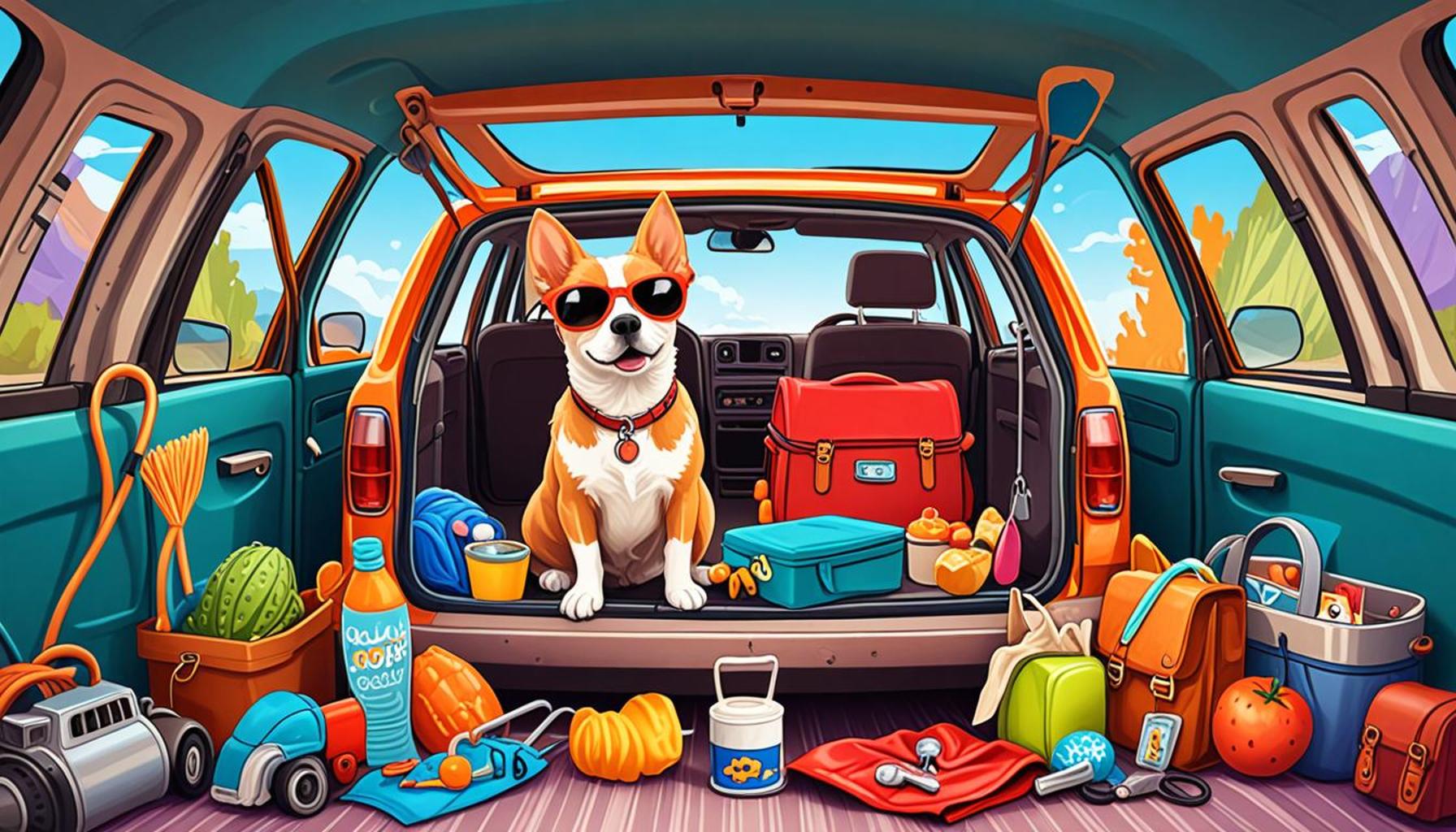How to prepare your pet for a car trip

Preparing Your Pet for a Car Trip
Embarking on a car trip with your furry friend can be an exciting adventure, but it requires substantial preparation. Knowing how to ensure your pet’s safety and comfort is crucial for a stress-free experience, particularly when you are traveling long distances or navigating through unfamiliar territories.
Assessing Your Pet’s Needs
Start by evaluating your pet’s behavior in various situations. Understanding your pet’s specific needs and temperament will help tailor your travel preparations effectively. Some pets may feel anxious while traveling, which could lead to potential issues during your trip. Take the time to assess the following:
- Age – Older pets might be less adaptable to long car rides and may require more frequent breaks to stretch their legs and relieve themselves. Consider planning shorter travel days or incorporating more stops.
- Health – Ensure any underlying medical conditions are addressed before hitting the road. It may be advisable to consult with your veterinarian to discuss any necessary medications or adjustments in routine food and care.
- Temperament – Some pets are naturally more nervous than others. Nervous pets might benefit from soothing products like pheromone sprays or anxiety wraps. Additionally, consider investing time in training to help them become accustomed to car travel.
What to Bring Along
Next, packing essential items to keep your pet comfortable during the journey is vital. A comprehensive packing list can ensure you are prepared for any situation on the road. Essential items can include:
- Food and water – Bring enough for the entire trip, plus some extra in case of delays. Also, consider portable food and water dishes for ease of serving during breaks.
- Leash and harness – These are essential for safe bathroom breaks. Ensuring your pet is secure during stops will prevent any unexpected escapes in unfamiliar areas.
- Pet seat cover – This not only protects your vehicle’s upholstery but can also provide your pet with a familiar surface that enhances comfort during travel. Look for washable options for easy clean-up.
- First aid kit – Having a pet-specific first aid kit on hand can be a lifesaver in case of a minor medical issue while on the road.
Familiarizing Your Pet with the Vehicle
Finally, make sure to familiarize your pet with the car. Short practice rides can help ease anxiety and build confidence before embarking on longer trips. Start with five to ten-minute sessions, gradually increasing the duration. During these short trips, reward your pet for calm behavior to positively reinforce the experience.
Always remember to keep the windows closed or slightly ajar to ensure their safety and to use a proper pet restraint or crate during the ride. A little preparation can make a significant difference, ensuring your trip is enjoyable for both you and your pet. Ultimately, traveling with a well-prepared pet paves the way for memorable adventures together.

DISCOVER MORE: Click here to learn about balanced nutrition for your dog’s health
Understanding Your Pet’s Behavior
Before setting out on your journey, it’s essential to understand your pet’s behavior and how they typically respond to new environments or changes in routine. Being able to predict your pet’s reactions can help ease both their stress and yours. Here are several aspects of behavior to observe:
- Previous Travel Experience – Consider your pet’s travel history. For example, if your dog has taken family road trips to the beach and enjoyed frolicking in the sand, they may be more excited about future travels. Conversely, if their past journeys involved long wait times, crowded vet visits, or unpleasant experiences, you will need to take proactive measures to mitigate anxiety. Gradually desensitizing your pet to travel, perhaps by taking short car rides that end in fun locations, can gradually create positive associations.
- Signs of Stress – Being vigilant for signs of stress is vital. Look out for behaviors such as whining, excessive panting, drooling, or pacing. For example, if your cat starts to hide or your dog refuses food, these can be indicators of discomfort. Recognizing these signs early allows you to address them—perhaps by employing soothing techniques such as playing calm music, offering a favorite toy, or using pheromone sprays designed to ease anxiety. Frequent short stops during long trips can help alleviate symptoms of stress.
- Routine Preferences – Pets thrive on routine; any disruption can lead to anxiety. It’s beneficial to maintain your pet’s regular feeding and bathroom schedule as closely as possible while on the road. If your pet typically eats at 8:00 AM, try to ensure they have their meal at the same time, even if it’s in a car. Bringing along their favorite blanket or toy can also provide comfort by invoking feelings of familiarity. This consideration for routine is key to keeping your pet at ease during travel.
Plan for Comfort During the Journey
Planning for your pet’s comfort is crucial when embarking on travel. Being on the road for extended periods can be challenging for them if not properly managed. Here are some strategies to make the trip more enjoyable:
- Use the Right Restraint – Safety is paramount. Invest in a quality pet seatbelt, harness, or crate that keeps your pet securely in place. This not only protects their well-being but also minimizes distractions for the driver. For instance, an unsecured pet may wander into the driver’s lap, resulting in unsafe driving conditions. In many states, having your pet properly restrained is not only safer but also required by law.
- Temperature Control – Make sure to maintain a comfortable temperature in the vehicle. A car can quickly heat up, particularly in the height of summer, leading to potential heatstroke, which can be extremely dangerous for your pet. Carrying a portable fan or ensuring that windows are slightly open can help. Remember, it may be wise to monitor local weather conditions before your trip, especially when traveling to areas that experience extreme temperature changes.
- Frequent Breaks – Plan to stop every couple of hours for bathroom breaks and stretching. Regular stops are essential for keeping your pet hydrated and allowing them to relieve themselves comfortably. Stretching and moving around can also help in reducing restlessness and fatigue. During these breaks, let your pet explore a bit; this stimulation can greatly enhance their overall travel experience.
In addition to these considerations, do your research about pet-friendly locations along your route. Many travel apps and websites offer listings of hotels, parks, and restaurants that welcome pets, making your journey even more enjoyable. Always keep an eye out for signs of stress and be prepared to adjust your plans as necessary. A mindful approach to your pet’s needs will pave the way for a successful and memorable car trip. By being prepared and attentive to your pet’s behavior, you are not just ensuring their comfort but also making lasting memories along the way.
Essential Preparations for a Smooth Car Trip with Your Pet
When planning a car trip with your pet, preparation is crucial to ensure a safe and enjoyable experience for both of you. Here are some key considerations and steps you can take to make the journey smoother:
| Preparation Category | Details |
|---|---|
| Safety Measures | Secure your pet using a harness or crate to prevent distractions. |
| Health Precautions | Visit the vet for a health check and ask about motion sickness remedies if needed. |
| Comfort Essentials | Bring familiar items like a favorite blanket and toys to reduce anxiety. |
| Hydration and Nutrition | Pack enough water and snacks to keep your pet hydrated and fed during the trip. |
| Frequent Breaks | Plan stops every couple of hours for bathroom breaks and stretching. |
It’s also vital to familiarize your pet with car rides prior to a long trip. Take shorter drives to help them acclimate and gauge their comfort level. This also helps to identify any specific issues they might have, such as car sickness or anxiety, allowing you to address them before the longer journey. Don’t forget to use proper restraints and safety harnesses available in pet stores to ensure your pet is secure. Additionally, consider a pet seat cover to protect your car’s interior and make the clean-up easier. Always keep your pet’s health records on hand during travel, just in case of emergencies. Taking these preparations seriously ensures not just a peaceful trip, but also strengthens the bond between you and your furry companions.
DISCOVER MORE: Click here to learn how positive reinforcement can change your pet’s behavior
Health Considerations and Packing Essentials
Beyond understanding your pet’s behavior and ensuring their comfort during travel, it’s important to consider their health and what to bring along on your journey. Preparing your pet for a car trip also involves a bit of planning regarding their medical needs and packing the right essentials. Here are some key points to contemplate:
- Veterinarian Visit – Before embarking on your trip, schedule a visit to your veterinarian. Ensure your pet is up-to-date on vaccinations and inquire whether any medications or supplements may be beneficial during travel. For pets prone to motion sickness, your vet may prescribe medication to alleviate symptoms during the journey. This proactive step is more than just advice; it’s about safeguarding your pet’s health while on the road.
- Identification and Microchipping – One of the most crucial aspects of traveling with pets is ensuring they can be identified in the event they become separated from you. Invest in a high-quality, durable collar with ID tags displaying your contact information. If your pet is not already microchipped, this might be a good time to consider it. Microchipping significantly increases the chances of a reunion should your pet wander off during the trip.
- Essential Supplies – Create a packing list that accommodates your pet’s needs, making sure to include essentials like food, water, bowls, leashes, waste bags, and grooming supplies. Bringing a familiar blanket or a favorite toy can ease anxiety by creating a sense of home in the car. If your pet takes medication, ensure you have an adequate supply and keep it in a designated area for easy access while traveling.
Navigating New Environments
Once you hit the road, your pet will need to adapt to new environments, which can be both exciting and daunting. Here are some tips for managing these transitions:
- Research Pet-Friendly Stops – Mapping out your route can save time and stress. Research pet-friendly rest stops, parks, and accommodations ahead of time. Many apps can help you find hotels that welcome pets, along with travel amenities like dog parks or pet-friendly restaurants. Knowing where you can stretch your pet’s legs or find a safe place to rest can enhance the travel experience immensely.
- Gradual Exposure – If your destination involves different climates or geographical areas, gradually exposing your pet to these changes is beneficial. For example, if you live in a colder climate and plan to travel south, consider acclimatizing your pet slowly to avoid any health issues due to abrupt climate changes. This may include allowing them some time to adjust to warmth before letting them run around.
- Minimize Overstimulation – During travel, your pet may encounter new sights, sounds, and smells. While this can be stimulating, excessive stimulation can lead to anxiety. Monitor your pet’s body language and take breaks if they appear overwhelmed. Set aside quiet time during longer stops to allow your furry traveler to relax and recharge for the next leg of the journey.
All of these considerations will not only ensure that your pet enjoys the car trip but also foster a bond between you as you explore new places together. The journey can be just as enjoyable as the destination when you’ve planned thoroughly. Remember that an organized approach, combined with understanding your pet’s needs, can take the stress out of traveling and help create memorable experiences.
DIVE DEEPER: Click here to learn how positive reinforcements can change your pet’s behavior
Final Thoughts on Preparing Your Pet for a Car Trip
Traveling with your pet can be a delightful experience, transforming a routine road trip into an adventure filled with new sights and experiences. As we have explored, the key to a successful journey lies in thorough preparation. Ensuring your furry friend is physically healthy and mentally ready for the trip paves the way for a smooth ride. From scheduling a veterinarian visit to address any medical concerns, to ensuring your pet has proper identification, every step you take contributes to their well-being and your peace of mind.
Moreover, adequately packing essential supplies not only caters to their basic needs but also helps maintain a sense of security. Remember to incorporate breaks and quiet time to manage environmental stressors, which can greatly enhance their travel experience. Familiarization with pet-friendly stops along your route can prove invaluable, providing moments for exploration and relaxation. In the grand scheme, it’s the planning and attention to detail that play a significant role in how well your pet handles the adventure.
By embracing these strategies, you can assure that the journey is just as pleasurable as the destination. So grab those leashes, stock up on treats, and hit the road—your next amazing travel story with your pet awaits. Together, you’ll create cherished memories, transforming every car trip into a meaningful chapter of your shared life.


